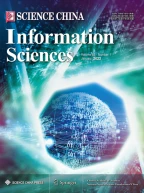Abstract
In this paper, we investigate the physical-layer secrecy outage performance of underlay spectrum sharing systems over Rayleigh and log-normal fading channels in the presence of one eavesdropper. In particular, the secondary transmitter sends data to the legitimate receiver under the constraints of the interference temperature at the primary receiver, while suffering the wiretap from the eavesdropper. Closed-form and approximated expressions are derived for the secrecy outage probability over Rayleigh and log-normal fading channels, respectively. The accuracy of our performance analysis is verified by simulation results.
摘要
中文摘要
在Underlay频谱共享系统中, 本文分别基于Rayleigh和log-normal衰落信道研究了存在一个窃密者时的物理层保密中断性能。当次级发送者在向次级接收者发送数据时, 不仅其发射功率受到主用户干扰功率容限的限制, 同时还要遭到窃密者的窃听。在Rayleigh和log-normal衰落信道下, 本文分别推导出了保密中断概率的准确和近似闭式表达式。最后, 通过了蒙特卡洛仿真验证了本文提出的性能分析模型。
创新点
本文首次研究了Underlay频谱共享系统分别在Rayleigh和log-normal衰落信道中的物理层保密中断性能, 并分别推导出了准确和近似闭式表达式。
Similar content being viewed by others
References
Wyner D. The wire-tap channel. Bell Syst Tech J, 1975, 54: 1355–1367
Bloch M, Barros J, Rodrigues M R D, et al. Wireless information theoretic security. IEEE Trans Inf Theory, 2008, 54: 2515–2534
Liu T, Shamai S. A note on the secrecy capacity of the multiple-antenna wiretap channel. IEEE Trans Inf Theory, 2009, 55: 2547–2553
Li Q, Song H, Huang K. Achieving secure transmission with equivalent multiplicative noise in MISO wiretap channels. IEEE Commu Lett, 2013, 17: 892–895
Li Q, Ma W-K, Man-Cho So A. A safe approximation approach to secrecy outage design for MIMO wiretap channels. IEEE Sig Process Lett, 2014, 21: 118–121
Sun X, Wang J, Xu W, et al. Performance of secure communications over correlated fading channels. IEEE Sig Process Lett, 2012, 19: 479–482
Liu X. Secrecy capacity of wireless links subject to log-normal fading. In: Proceedings of 7th International Conference on Communications and Networking in China, Kunming, 2012. 167–172
Zhang X, Pan G, Tang C, et al. Performance analysis of physical layer security over independent/correlated lognormal fading channels. In: Proceedings of Australasian Telecommunication Networks and Applications Conference, Melbourne, 2014. 23–27
Zahurul M, Sarkar I, Ratnarajah T. Secrecy capacity over correlated log-normal fading channel. In: Proceedings of IEEE International Conference on Communications, Ottawa, 2012. 883–887
Mitola J. Cognitive radio: an integrated agent architecture for software defined radio. Dissertation for Ph.D. Degree. Stockholm: KTH, 2000
Shu Z, Qian Y, Ci S. On physical layer security for cognitive radio networks. IEEE Netw, 2013, 27: 28–33
Zou Y, Wang X, Shen W. Physical-layer security with multiuser scheduling in cognitive radio networks. IEEE Trans Commu, 2013, 61: 5103–5113
Sakran H, Shokair M, Nasr O, et al. Proposed relay selection scheme for physical layer security in cognitive radio networks. IET Commun, 2012, 6: 2676–2687
Wen H, Li S, Zhu X, et al. A framework of the PHY-layer approach to defense against security threats in cognitive radio networks. IEEE Netw, 2013, 27: 34–39
Tang C, Pan G, Li T. Secrecy outage analysis of underlay cognitive radio unit over Nakagami-m fading channels. IEEE Wirel Commun Lett, 2014, 3: 609–612
Elkashlan M, Wang L, Duong T Q, et al. On the security of cognitive radio networks. IEEE Trans Veh Techol, 2015, 64: 3790–3795
Papoulis A. Probability, Random Variables and Stochastic Processes. 4th ed. New York: McGraw Hill, 2001
He F, Man H, Wang W. Maximal ratio diversity combining enhanced security. IEEE Commun Lett, 2011, 15: 509–511
Krishnamoorthy K. Handbook of Statistical Distributions with Applications. New York: Chapman & Hall, 2006
Fenton L. The sum of log-normal probability distributions in scatter transmission systems. IRE Trans Commun Syst, 1960, 8: 57–67
Pan G, Tang C, Zhang X, et al. Physical layer security over non-small scale fading channels. IEEE Trans Veh Tech, 2016, 65: 1326–1339
Author information
Authors and Affiliations
Corresponding author
Rights and permissions
About this article
Cite this article
Liu, H., Zhao, H., Jiang, H. et al. Physical-layer secrecy outage of spectrum sharing CR systems over fading channels. Sci. China Inf. Sci. 59, 102308 (2016). https://doi.org/10.1007/s11432-015-5451-2
Received:
Accepted:
Published:
DOI: https://doi.org/10.1007/s11432-015-5451-2
Keywords
- spectrum sharing
- cognitive radio
- secrecy outage probability
- Rayleigh fading channels
- log-normal fading channels
